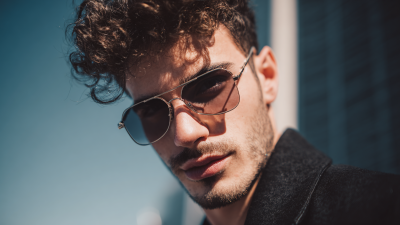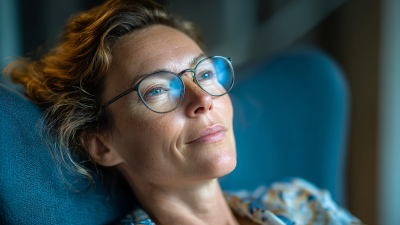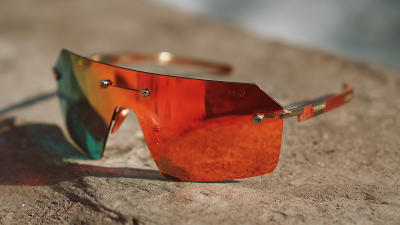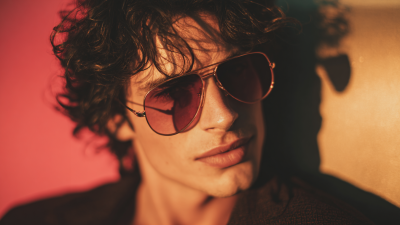As the demand for stylish and functional eyewear continues to rise, bifocal glasses have emerged as a popular choice for those seeking both vision correction and aesthetic appeal. According to a recent report by Grand View Research, the global eyewear market is expected to reach $183.24 billion by 2027, with bifocal glasses playing a significant role in this growth. The increasing prevalence of age-related vision conditions, such as presbyopia, is propelling innovation within this niche, leading to unique designs that cater to a variety of tastes and preferences.

In this blog, we will dive into the world of bifocal glasses, exploring innovative examples that not only enhance visual clarity but also serve as a fashion statement, appealing to a diverse range of consumers. Join us as we uncover the creative styles redefining bifocal eyewear and how these designs cater to the needs of the modern wearer.
Bifocal glasses have long been recognized for their functionality, seamlessly combining two prescriptions in one lens to cater to different vision needs. However, modern designs are breaking away from the traditional, mundane styles that often accompany these essential eye care tools. Today’s bifocal glasses are not just about vision correction; they are a statement of personal style that embraces the latest fashion trends while effectively addressing the needs of diverse wearers. From bold geometric frames to understated classic shapes, the options are endless.
Innovative bifocal designs are now incorporating vibrant colors, unique patterns, and versatile materials, allowing individuals to express their personality and taste. Designers are experimenting with lightweight composites that provide all-day comfort without sacrificing durability. Moreover, many brands are embracing sustainability, utilizing eco-friendly materials that cater to the environmentally conscious consumer. This blend of artistic flair and practical advantages ensures that bifocal glasses are not just a necessity but a chic accessory that enhances any outfit, enabling wearers to navigate their day-to-day lives with confidence and style.
As we delve into the necessity for bifocal glasses, it's essential to consider the statistics surrounding presbyopia, a common vision condition that affects individuals as they age. According to the American Optometric Association, approximately 1 in 2 people over the age of 40 experience some degree of presbyopia. By the age of 50, nearly 83% of individuals require corrective lenses for near vision tasks. This trend emphasizes the importance of understanding how different age groups grapple with visual changes and the increasing demand for bifocal solutions.
Moreover, a report by the Vision Council indicates that nearly 70% of adults aged 45 and older have some need for vision correction, with bifocals being a popular choice for managing both nearsightedness and farsightedness. The desire for stylish and functional eyewear is on the rise, particularly among Baby Boomers and Generation X, who are not only looking for effective solutions but also for designs that reflect their personal style. As optical technology advances, the variety of bifocal styles—from classic to contemporary designs—ensures that there is a fashionable choice for everyone facing the challenges of presbyopia.
| Age Group | Percentage of Presbyopia Cases | Preferred Bifocal Style (%) | Common Issues Faced (%) |
|---|---|---|---|
| 40-49 | 25% | 35% (Modern Designs) | 10% (Adaptation Problems) |
| 50-59 | 40% | 50% (Classic Designs) | 20% (Limited Vision Range) |
| 60-69 | 60% | 40% (Fashionable Styles) | 30% (Inaccurate Prescription) |
| 70+ | 80% | 55% (Comfortable Fit) | 40% (Heavy Frames) |
Bifocal glasses have come a long way from their traditional designs, now embracing trendy materials and innovative technologies that enhance both comfort and style. Modern bifocal eyewear features lightweight frames made from high-quality plastics and metals, ensuring that wearers can enjoy all-day comfort without the burden of heavy glasses. Additionally, the introduction of flexible materials allows frames to adapt to various face shapes, providing a snug fit that enhances both performance and appearance.
Tips for choosing the right bifocal glasses include considering the lens height and placement to ensure a seamless transition between vision zones. Make sure to try on different frame styles to find one that complements your facial features and fits your personal aesthetic. Furthermore, explore options with anti-reflective and scratch-resistant coatings, which can add durability and clarity to your lenses, making them a wise investment for your vision health and style.
As technology advances, features such as custom lens crafting and digital measurements are becoming mainstream, allowing for a more personalized experience. Look for brands that offer virtual try-ons or consultations, ensuring that your bifocal glasses not only match your aesthetic preferences but also meet your specific vision needs.
In today's fast-paced world, bifocal glasses are stepping outside the realm of mere functionality, embracing innovative aesthetics that appeal to diverse consumer tastes. Brands have begun to recognize the importance of merging style with purpose, resulting in unique designs that cater to individuals looking to make a statement while addressing their vision needs. For instance, Luxottica has successfully introduced a line featuring bold colors and modern frames, turning traditional bifocals into fashionable accessories. Their collaboration with contemporary artists adds a touch of artistic flair, appealing to a younger demographic that values both vision correction and personal expression.

Another noteworthy example is Warby Parker, a brand known for its commitment to affordability without compromising style. Their approach to bifocal glasses includes retro-inspired frames combined with sleek, minimalist designs that attract the fashion-forward consumer. By offering a range of customizable options, they empower wearers to create a look that reflects their personal style. This blend of innovation and accessibility demonstrates how successful brands are redefining bifocal glasses, transforming them into more than just a vision aid but a key element of personal style.
The global eyewear market has experienced remarkable transformation in the wake of the COVID-19 pandemic, with significant shifts in consumer preferences reflected in the surging popularity of bifocal glasses. Recent data indicates that the U.S. eyewear market is projected to reach a staggering USD 30.3 billion by 2033, boasting a compound annual growth rate (CAGR) of 5.2%. This growth is not just a statistical anomaly but also a reflection of changing consumer attitudes towards style and functionality, particularly among those opting for bifocal designs that cater to diverse aesthetic preferences while addressing vision needs.

Surveys from The Vision Council reveal that sustainability and advanced technology are pivotal factors shaping consumer choices in eyewear. As more individuals lean towards environmentally friendly options, there is a growing inclination for bifocal glasses that not only perform well but also make a style statement. Shoppers increasingly prioritize personalized experiences in their purchasing journey, catering to their unique tastes. The shift towards healthier alternatives, underscored by emerging trends in various markets, also influences eyewear decisions, as consumers seek products that align with their lifestyle choices. The continuous evolution in the bifocal segment showcases the dynamic interplay between innovative design and consumer expectations.






